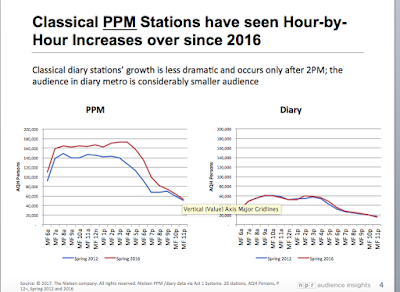We have been looking at Classical music radio ratings information
for quite a few years. Usually there are
only small variations from book to book. This is not true of the most recent estimates from Nielsen Audio. Using August 2017 PPM data and comparing
it with data from August 2014, we are seeing unprecedented fluctuations within this cohort of stations.
We currently track 32 Classical music stations in Nielsen
PPM markets. There are 27 for which we have both 2014 and 2017 estimates. Of
those 27 stations, seven (26%) increased their number of weekly listeners
during the three year period; another seven stations stayed about the same; and
13 (48%) stations lost 5% or more of their weekly listeners.
The gains and losses were seen in the biggest Classical
music stations in the nation, seemingly without a pattern or precedent. How can
KBAQ in Phoenix increase their estimated number of weekly listeners by 48%, and
KPAC in San Antonio lose 40% of their weekly listeners?
We broke the results into three charts. Scroll down to see the
results for all 32 stations.
The first group shows the gainers. Nielsen estimates show
that KBAQ added 100,000 weekly listeners during the three-year period.
All of
these stations air full-time Classical music except WIBC in Indianapolis, a
Jazz/Classical hybrid.
The next group shows the stations that have lost 5% or more of
their estimated weekly listeners during the three-year period.
As you can see,
some well-known folks lost a lot of weekly listeners. KING in Seattle lost over
100,000 weekly listeners between August 2014 and August 2017, 35%. KUSC in Los
Angeles had the largest number of lost weekly listeners, over 150,000 (20%).
Three of the stations on the chart are dual format stations.
The final group shows the seven stations where the number of
estimated weekly listeners grew or declined less than 5% over the three-year
period.
Why is this happening?
We decided to ask observers who know more about Classical music then we
do.
Wende Persons, Managing Director of SRG’s Classical Music Rising
initiative, says stations gaining listeners probably invested in stronger
branding. Marketing and promotion:
"Focused
promotion really works. Just look at KBAQ in Phoenix with its 'Make Your
Commute Great Again' billboards, launched after the Presidential Inauguration.
KBAQ’s share rose to 3.4 in August - in contrast to some slack summer numbers
at other stations. KBAQ's average share in 2016 was 1.7, and the weekly cume
this year is up 21%."
 |
| click to enlarge |
Persons provided a chart from a 2017 report by NPR Audience
Insights (on the right)
that demonstrates that many stations have solid daytime strength, the time
period when the most people hear radio.
Information about the performance of
Classical music radio stations can be found on the Classical Music Rising website here.
We also heard from Scott Williams, the Director of Audience
Research for KJZZ and KBAQ in Phoenix. Williams also
says that the difference between gainers and loser is likely a factor of their
investment in promotion and visibility:
"In 2014 the RRC
commissioned a study by Coleman Insights on the state of classical radio.
The conclusion was while the appetite for classical music remains strong across
the country classical radio stations suffer from low awareness.
"As a result, KBAQ
invested heavily in billboard campaigns in the first quarter of both 2016 and
2017, as well as brief fall campaigns. This dramatically increased KBAQ's
listening."
KANSAS LAWMAKER
TWEETS HE WOULD RATHER GIVE MONEY TO NORTH KOREA THAN PUBLIC RADIO
Perhaps you know people who are intensely opposed to government
support for public broadcasting. But few people reach the level of vitriol expressed
by Kansas Representative J.R. Claeys (R-Salina). Claeys who recently tweeted:
Such an outburst didn’t surprise Peter Hancock, a reporter
and columnist for the Lawrence Journal-
World, who first reported this story [link].
 |
| Kansas Rep J.R. Claeys |
According to Hancock, Rep. J.R. Claeys was spurred to send
his tweet after he heard a Kansas Public Radio (KPR) message during its
"Power Hour" event, a single- morning fundraising drive that precedes
the regular fall pledge drive. Here is the sequence of events in Hancock’s
words:
Around 7:45 a.m.,
KPR's Statehouse reporter Stephen Koranda tweeted, "There's still time to
support KPR and our coverage during the power breakfast today."
To which, Claeys
replied: "I'd sooner give to DPRK News. At least their praise of dear
leader is under duress."
An outgoing message on
Claeys’ telephone indicated that he was out of the country until Sept. 11.
However, in response to a direct message via Twitter asking for him to clarify
his remark, Claeys wrote: “Why would anyone be surprised that a republican
would publicly balk at funding a democrat radio station?”
Claey’s did not say why he favored giving money to North
Korea. All of this drama led to a reader of Hancok’s column to
post this comment:










No comments:
Post a Comment